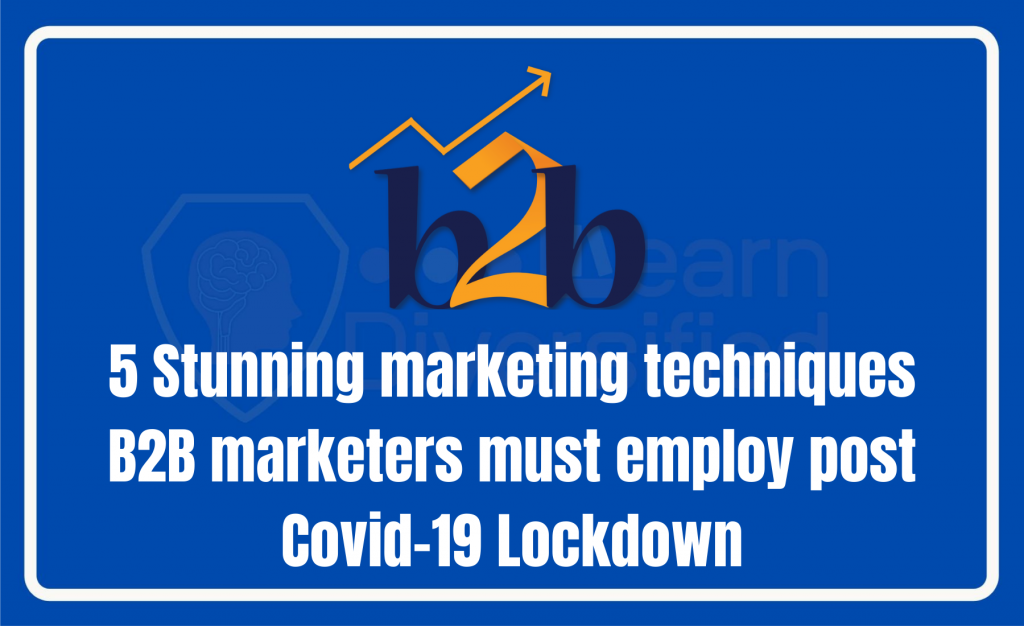The impacts of the Covid-19 on the worldwide economy have been disastrous. The business sectors have fallen for the 3rd time on March 16, not long after the US Federal Reserve again brought down its interest rates. The terrified markets are accepting the Fed’s move as a definite indication of an approaching downturn.
5 stunning B2B marketing strategies for B2B marketers,
The difficulties achieved by the Covid-19 pandemic are novel, multifaceted, and reliant.
CEOs must reexamine their courses to showcase as channel partners either change rapidly or flop quick. They must alter their supply chains as basic segments seem to be ‘cut off ‘(Allen J, 2020).
B2B Marketers must re-evaluate the methods of working in another virtual world. They must review each cost.
Given the probability of re-occurrence because of new infections/mutations and the high chance of catastrophic natural occasions emerging from environmental change, what B2B marketing strategies can marketers use when these circumstances happen?
The ancient Greek philosopher Plato said that
Necessity is the mother of invention
which implied when placed in a troublesome circumstance, one is probably going to be roused to make a novel or brilliant arrangement to endure and battle that circumstance.
We are here recommending 5 stunning B2B marketing strategies as innovative marketing plans of action which will help B2B marketers to gain from and acclimate to the present crisis, which will profoundly impact their presentation in tomorrow’s changing world.
-
Quicken interest in ‘Self-Service Touchless Technologies’ considering changing customer needs:
B2B businesses are compelled to develop new capacities for remote activity practically overnight, complete digital transformations in weeks as opposed to months or years, and propelled new products and services surprisingly fast in response to the changing consumer needs.
This gave even more purchasing capacity to primarily digital buyers and they likewise requested a thorough digital support system. So ‘Self-service touchless technologies’ (SSTT) is the quickest developing channel in customer support in the “new normal”.
SSTT choices for consumers are those that can complete work in manners that would previously always mean engaging with another human being. This is the capacity to customize the customer experience, customer satisfaction, and to assist customers with doing things themselves.
B2B marketers who haven’t constructed SSTT capacities, there’s no better an ideal opportunity to begin now. Self-service channels and platforms will support workers, consumers, and channel accomplices to get what they need with less hands-on from IT and business.
-
Artificial Intelligence (AI) and Analytics devices to make human-like associations with customers to improve business activities:
It is no doubt that AI plays an important role in developing brilliant B2B marketing strategies. The use of AI will be colossally important in helping organizations adjust to these evolving patterns. AI-enabled platforms will assist B2B marketers better simulate live workplaces and generate on-demand labour forces.
Through machine learning and advanced data analytics, AI will assist B2B marketing companies with recognizing new consumption patterns and convey “hyper-customized” products to online customers.
The best organizations will be those that consistently combine AI with human judgment and experience.
Smart Chatbots, for example, will flourish in the new normal. They are enabled by AI and can communicate with humans in real-time. Later, chatbots are required to help in drawing in sales prospects and B2B lead generation.
-
Employ ‘Design thinking’ to help companies provide innovative digital offerings:
In view of that data, the organization’s team taking a shot at the product or service can devise techniques and plans, which must be conceivable with a detailed level of understanding about their expected customer base.
At the end of the day, design thinking advances an answer-based way to deal with taking care of issues, as opposed to being product or service-oriented, while remaining ignorant of their buyers’ requests.
B2B Companies can lean towards planning applications, products, or services by adopting design thinking, which can tackle complex issues while being innovative.
B2B marketers who can use things like design thinking into their new offerings during the Covid-19 crisis will see a critical first-mover advantage in the prompt term and will make a competitive advantage in the next normal.
-
The pliability with variable cost base is required to make versatile supply chains:
B2B companies that are adaptable with a variable cost base and prepared to react to dynamic changes occurring in unpredictable conditions are better ready to deal with the Covid-19 supply chain shock.
Digital tools are helping organizations to recognize new wellsprings of strength. AI offers the potential for B2B marketers to incorporate versatility with manufacturing and supply chains, while simultaneously limiting expense and damage to margins.
AI empowers producers to advance expenses in every manufacturing plant through predictive maintenance and better planning. Eventually, the universal spread of the Covid-19 has quickened the premium on adaptability in supply chains, including in partner terms and sourcing with variable cost base structure.
-
Plan structural performance improvement projects/programs to move activities to variable cost structures:
To defeat the ongoing Covid-19 emergency rapidly and react to the ‘new normal’ of lower incomes in the medium-term, most companies must employ structural performance improvement programs.
For these projects, Top-level administration will initially need to build up a reasonable objective picture for the organization in 3 to 5 years. This could incorporate the future core business model and operating model.
Based on this they will require to deploy mechanisms such as value sourcing, contract manufacturing, transportation fleet leasing, third party warehousing, and overhead cost reduction but also top-line levers like introducing new pricing mechanisms or similar.
A coordinated approach will guarantee the focused delivery of such a comprehensive program. This is not likely a quick-hit measure for most companies, however, it might be essential to longer-term cash flow management, depending upon to what extent demand and supply chains are upset by Covid-19.
B2B marketers those will modernize their B2B marketing strategies according to the new reality by reshaping themselves by putting SSTT, Artificial intelligence and analytics, Design thinking, pliable supply chain with variable cost base and design structural programs at the core of their business will not just recover from this crises but will emerge as winners with the best strength and with incredible chance to characterize a reconsidered future.
I hope the above discussed B2B marketing strategies will help you to some extent in this COVID situation.
For more interesting articles, click HOME.

